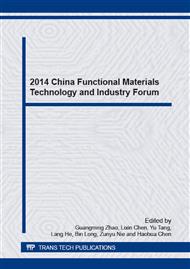[1]
X.H. Xu: The Geometries, Electronic of Nickel Clusters and Influence of its complexes at Nickel Clusters. (Ms. D. Dissertation, Shandong Normal University, China. 2005).
Google Scholar
[2]
T. Nakazawa, T. Igarashi, T. Tsuru and Y. Kaji: Comp. Mater. Sci., Vol. 46 (2009), P. 367.
Google Scholar
[3]
H.D. Zhang: The study of Nin(n=1~13) clusters with first principles. (Ms. D. Dissertation, Nanjing Normal University, China. 2006).
Google Scholar
[4]
F.A. Reuse and S.N. Khanna: Chem. Phys., Vol. 234 (1995), P. 77.
Google Scholar
[5]
Q.L. Lu, Q.Q. Luo and L.L. Chen: Eur. Phys. J. D, Vol. 61 (2011), P. 389.
Google Scholar
[6]
J.C. Pinegar, J.D. Langenberg, C.A. Arrington, E.M. Spain and M.D. Morse: J. Chem. Phys., Vol. 102 (1995), P. 666.
Google Scholar
[7]
V.G. Grigoryan and M. Springborg: Phys. Rev. B, Vol. 70 (2004), P. 205415.
Google Scholar
[8]
E.K. Parks, L. Zhu, J. Ho and S.J. Riley: J. Chem. Phys., Vol. 100 (1994), P. 7206.
Google Scholar
[9]
F.A. Reuse and S.N. Khanna: Chem. Phys. Lett., Vol. 234 (1995), P. 77.
Google Scholar
[10]
S.K. Nayak, S.N. Khanna, B.K. Rao and P.J. Jena: Phys. Chem. A, Vol. 101 (1997), P. 1072.
Google Scholar
[11]
M.C. Michelini, R. Pis Diez and A.H. Jubert : Int. J. Quant. Chem., Vol. 85 (2001), P. 22.
Google Scholar
[12]
S. Bouarab, A. Vega, M.J. L'opez, M.P. Iniguez and J.A. Alonso: Phys. Rev. B, Vol. 55 (1997), P. 13279.
Google Scholar
[13]
S.N. Khanna, M. Beltran and P. Jena: Phys. Rev. B, Vol. 64 (2001), P. 235419.
Google Scholar
[14]
E. Curotto, A. Matro, D.L. Freeman and J.D. Doll: J. Chem. Phys., Vol. 108 (1998), P. 729.
Google Scholar
[15]
Z. Xie, Q.M. Ma, Y. Liu and Y.C. Li : Phys. Lett. A, Vol. 342 (2005), P. 459.
Google Scholar
[16]
R.C. Longo and L. Gallego: J. Phys. Rev. B, Vol. 74 (2006), P. 193409.
Google Scholar
[17]
F. Aguilera-Granja, A. Garc' a-Fuente and A. Vega: Phys. Rev. B, Vol. 78 (2008), P. 134425.
Google Scholar
[18]
R. Singh and P. Kroll: Phys. Rev. B, Vol. 78 (2008), P. 245404.
Google Scholar
[19]
F. Aguilera-Granja, J.M. Montejano-Carrizales and R.A. Lo'pez: Phys. Rev. B, Vol. 73 (2006), P. 115422.
Google Scholar
[20]
M.B. Knickelbein, S.H. Yang and S.J. Riley: J. Chem. Phys., Vol. 93 (1990), P. 94.
Google Scholar
[21]
S.E. Apsel, J.W. Emmert, J. Deng and L.A. Bloomfield: Phys. Rev. Lett., Vol. 76 (1996), P. 144.
Google Scholar
[22]
P. Jena, S.K. Nayak, S.N. Khanna and B.K. Rao: J. Phys. Chem. A, Vol. 101 (1997), P. 1072.
Google Scholar


